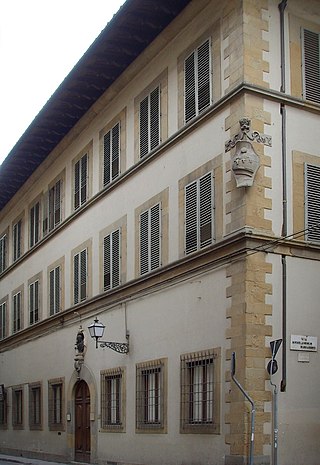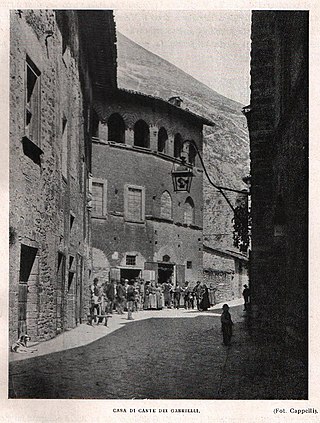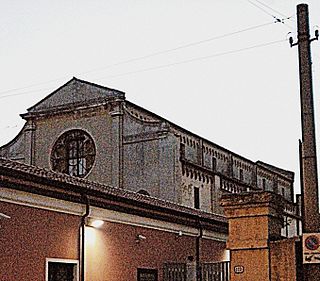Related Research Articles

Gubbio is an Italian town and comune in the far northeastern part of the Italian province of Perugia (Umbria). It is located on the lowest slope of Mt. Ingino, a small mountain of the Apennines.

The Accademia di San Luca is an Italian academy of artists in Rome. The establishment of the Accademia de i Pittori e Scultori di Roma was approved by papal brief in 1577, and in 1593 Federico Zuccari became its first principe or director; the statutes were ratified in 1607. Other founders included Girolamo Muziano and Pietro Olivieri. The Academy was named for Luke the Evangelist, the patron saint of painters.

San Marco is a religious complex in Florence, Italy. It comprises a church and a convent. The convent, which is now the Museo Nazionale di San Marco, has three claims to fame. During the 15th century it was home to two famous Dominicans, the painter Fra Angelico and the preacher Girolamo Savonarola. Furthermore, the church houses the tomb of Pico Della Mirandola, a Renaissance philosopher and the so called "Father of Humanism."

Santa Maria Maddalena dei Pazzi is a Renaissance-style Roman Catholic church and a former convent located in Borgo Pinti in central Florence, Italy.

Casa Buonarroti is a museum in Florence, Italy. The building was a property owned by the sculptor Michelangelo, which he left to his nephew, Leonardo Buonarroti. The house was converted into a museum dedicated to the artist by his great nephew, Michelangelo Buonarroti the Younger. Its collections include two of Michelangelo's earliest sculptures, the Madonna of the Stairs and the Battle of the Centaurs. A ten-thousand book library includes the family's archive and some of Michelangelo's letters and drawings. The Galleria is decorated with paintings commissioned by Buonarroti the Younger and created by Artemisia Gentileschi and other early seventeenth-century Italian artists.

The Biblioteca comunale Luciano Benincasa is located in Ancona, Italy, in the Palazzo Mengoni-Ferretti, at the central Piazza del Plebiscito.

The Scarabelli library is the public library in the city of Caltanissetta in the centre of the island of Sicily, Italy. In 1862, the library was established by Antonio Mordini in the premises of the former Jesuit convent.

The Palazzo del Capitano del Popolo or Palazzo di Cante Gabrielli is a medieval palace in Gubbio, Italy. It is located in the San Martino's quartiere, near Porta Metauro, at the corner of via Gabrielli and via Capitano del Popolo.

San Francesco is a Gothic-style, Roman Catholic church in the lower town of Gubbio, Umbria, in Italy.

The Basilica of Sant'Ubaldo is a Roman Catholic church atop Mount Ingino, outside central Gubbio in Umbria, Italy. The church houses the body of the patron saint of Gubbio, Saint Ubaldo, kept atop the main altar on a marble plinth, surmounted by a glass case.
The small church of Santa Croce della Foce is a medieval Roman Catholic church in the lower town of Gubbio, Umbria, in Italy. There is a church of the same name in Sarno in Campania.

The Marucelliana Library or Biblioteca Marucelliana, is a public library, founded by the mid-18th century, and located on Via Camillo Cavour # 43, in Florence, region of Tuscany, Italy.

San Giovanni di Verdara or Saint John of Verdara is a former Roman Catholic monastery and church located on Via San Giovanni di Verdara # 123, in the city of Padua, region of Veneto, Italy. It was founded in 1221, but now serves as a military hospital, and is not accessible to the public.

The Monastery of San Girolamo in Campansi is a former convent located on Via Campansi #18 in the city of Siena, region of Tuscany, Italy. The Baroque-style church still stands as an independent chapel; while the monastery has been converted to a nursing home for the elderly. There is a separate Monastery of San Girolamo on via San Girolamo, located in a different contrada of Siena.
Villa Colloredo Mels is a suburban palace located on Via Gregorio XII, on the western edge of the urban center of Recanati, province of Macerata, Marche, Italy. It presently houses the civic archeologic and art museum of the town.

The church and convent of the Santissima Annunziata is a Baroque-style, Roman Catholic church located on Piazza de Servi #4, Pistoia, region of Tuscany, Italy. The convent presently functions as a warehouse. The church is down via Laudesi from the San Desiderio, and via Piazza de Servi, From San Giovanni Decollato.
San Secondo is a Roman Catholic church and monastery located on Via Tifernate #6 just west of the medieval walls of Gubbio, region of Umbria, in Italy. The school of canons once associated with this church educated the patron saint of Gubbio, Saint Ubaldo (1085-1160).

The Monastero or Eremo di Sant'Ambrogio is a 14th-century Roman Catholic church and monastery located on Via Guido Bonarelli #5 nestled on high slopes of Monte Foce, north of Gubbio, region of Umbria, in Italy. It was initially founded as a rustic Franciscan hermitage following Augustinian rules, outside the city walls of Gubbio.

San Pietro is an ancient Roman Catholic church and former monastery located on piazza San Pietro in central Gubbio, region of Umbria, in Italy. The church which displays architectural elements from many centuries, from Romanesque to the Renaissance, as well as housing prominent artworks; the monastery now houses the civic Biblioteca Comunale Sperelliana.
The Palazzo del Bargello is a 14th-century Gothic architecture, civic palace located on Via del Consoli #35 in the historic center of Gubbio, region of Umbria, Italy. It now houses an exhibition or Museo della Balestra (crossbow-men), celebrated with a yearly festival. In front, of the palace is the Fontana di Matto, now whimsically used to award a "license to be crazy". Across the street is the small 13th-century church of San Giuliano, that gave name to a gate near here and this quarter of the city.
References
43°20′56″N12°34′53″E / 43.3488°N 12.5813°E